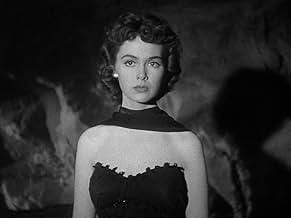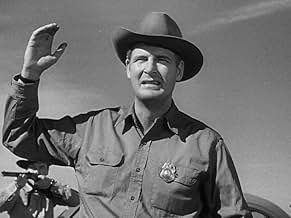Aggiungi una trama nella tua linguaA spaceship from another world crashes in the Arizona desert and only an amateur stargazer and a schoolteacher suspect alien influence when the local townsfolk begin to act strangely.A spaceship from another world crashes in the Arizona desert and only an amateur stargazer and a schoolteacher suspect alien influence when the local townsfolk begin to act strangely.A spaceship from another world crashes in the Arizona desert and only an amateur stargazer and a schoolteacher suspect alien influence when the local townsfolk begin to act strangely.
- Premi
- 1 vittoria e 4 candidature totali
- Posseman
- (non citato nei titoli originali)
- Dugan
- (non citato nei titoli originali)
- Man
- (non citato nei titoli originali)
- Sam
- (non citato nei titoli originali)
- Dave Loring
- (non citato nei titoli originali)
- Dr. Snell
- (non citato nei titoli originali)
- Perry
- (non citato nei titoli originali)
- Posseman
- (non citato nei titoli originali)
- Bob - Dr. Snell's Assistant
- (non citato nei titoli originali)
- Toby
- (non citato nei titoli originali)
- Posseman
- (non citato nei titoli originali)
- Mrs. Daylon
- (non citato nei titoli originali)
Recensioni in evidenza
Arnold uses Theremin music to great effect, the photography is eerie, dialog (by Ray Bradbury) poetic, and the alien is a large crawling mass with one bulging eye that leaves a snail-like trail in its path. Incognito as humans so as not to terrify earthlings with their unique physicality, the aliens are NOT bent on destruction - an interesting precursor to Steven Spielberg's expensive "Close Encounters of the Third Kind" (1977) - even its main titles are also at the end.
In an unconscious insight into social behavior, a scene has Carlson speaking to the sheriff (Charles Drake) while watching a spider on the desert ground ("...Why are you afraid of it? Because it has 8 legs, its mouth moves from side to side, instead of up and down? What would you do if it came towards you?"). The sheriff squashes it. This holds true for animals, as well as people (who have different coloring, etc.), avoiding, ridiculing, harming or destroying, sadly. The classic Twilight Zone episode "Eye of the Beholder" (1960) is a fine example: most of the "monsters" in these science-fiction/horror films just look different than humans, we might be "monsters" to them. This is low-key, intelligent, satisfying drama. Russell Johnson, Joe Sawyer, and Kathleen Hughes co-star.
It stars sci-fi regular Richard Carlson (Creature From the Black Lagoon) and Barbara Rush (When Worlds Collide) as his lover. They both play good parts.
This is also one of the creepiest sci-fi movies of the 1950's. The desert setting is very eerie, as is the score. Director Jack Arnold often used desert settings for his movies. The alien monster looks quite impressive and the special effects are good too.
I enjoyed this movie very much and is a must for 1950's sci-fi lovers. Enjoy!
Rating: 5 stars out of 5.
Set in and around a small town in the Arizona desert, it tells the story of an amateur astronomer who was trying to get to the truth behind a large, fiery object that fell to earth in the desert. Was it a meteroid, as the Army had proclaimed after its investigation, or a crashed space ship? Though he caught a glimpse of the latter, the evidence was buried in a landslide in the crater before anyone else got there.
Ray Bradbury's believable story is the now-common question of how we deal with things we don't understand, or are "ugly".
I thought it played well, had decent special effects, etc., for a film made for 1950s audiences' sensibilities and movie-watching sophistication.
One scene included a shapely, flirty young woman who really had nothing to do with the story. It wasn't until I heard this was a 3D movie that her presence on screen made any sense.
Between about 1975 and 1986, three 1950s sci-fi films were held in very high regard by me - It Came From Outer Space, Forbidden Planet and The Incredible Shrinking Man. All three were liked so much I constantly listened to them on audio tape. They were regarded as solid sci-fi movies to be taken very seriously. Then in the late 1980s I made the mistake of seeing these films in Sydney theatres with people who were not really in tune with 1950s movies. These films became comedy to them.
ICFOS begins with the male and female lead getting all romantic with each other. This cinema crowd almost laughed this scene off the screen. Too corny for them. Later, one character describes Richard Carlson as "a man who thinks for himself", the laughing was louder this time. And again, Carlson looks into space and starts talking to himself, out loud, about aliens. The laughing was getting stronger. And so it went on. What was once great mystery and suspense, such as Russell Johnson looking into the sun, was now comedy. They had good reason to laugh as it was funny. But this crowd destroyed a childhood favourite of mine. I did'nt like this film being laughed at. I did'nt want to know the funny side. Other cinema screenings of Forbidden Planet and The Incredible Shrinking Man were given the same reaction. For a while I wondered if all of my 1950s/1960s sci-fi favourites were just ... bad in the eyes of the public. Or was it just the Australian sense of humour?
I will rate this film by my 1970s reactions. It is a classic. The music score is dated but everything else is fine. The desert creates such mystery. Great sci-fi.
Lo sapevi?
- QuizAlthough credited to Harry Essex, most of the script, including dialogue, is copied almost verbatim from Ray Bradbury's initial film treatment.
- BlooperWhen the alien first goes walking about in the desert, the camera cuts to a startled owl, which tries to fly away only to be jerked back by the visible string tied to its leg.
- Citazioni
Sheriff Matt Warren: Did you know, Putnam, more murders are committed at ninety-two degrees Fahrenheit than any other temperature? I read an article once - lower temperatures, people are easy-going. Over ninety two, it's too hot to move. But just ninety-two, people get irritable.
- Curiosità sui creditiThe credits are at the end rather than at the beginning. They include shots of the characters with the cast names, and the pictures would mean nothing if seen before the film.
- Versioni alternativeThere is an Italian edition of this film on DVD, distributed by DNA Srl: "IT CAME FROM OUTER SPACE 3-D (1953) + L'UOMO DAL PIANETA X (1951)" (2 Films on a single DVD, with "Destinazione Terra!" in double version 2D and 3D), re-edited with the contribution of film historian Riccardo Cusin. This version is also available for streaming on some platforms.
- ConnessioniEdited into La meteora infernale (1957)
I più visti
Dettagli
Botteghino
- Budget
- 800.000 USD (previsto)
- Lordo in tutto il mondo
- 270 USD
- Tempo di esecuzione
- 1h 21min(81 min)
- Colore
























